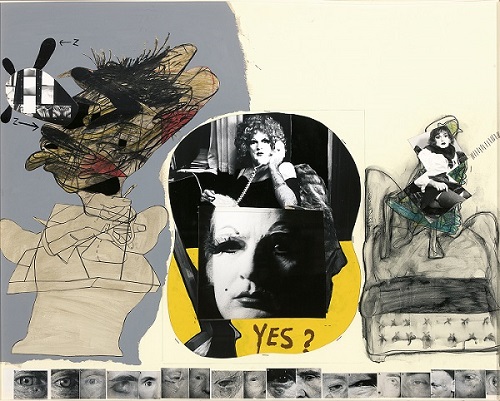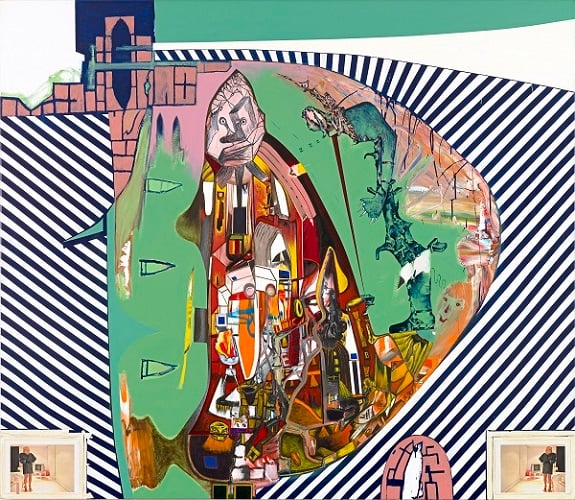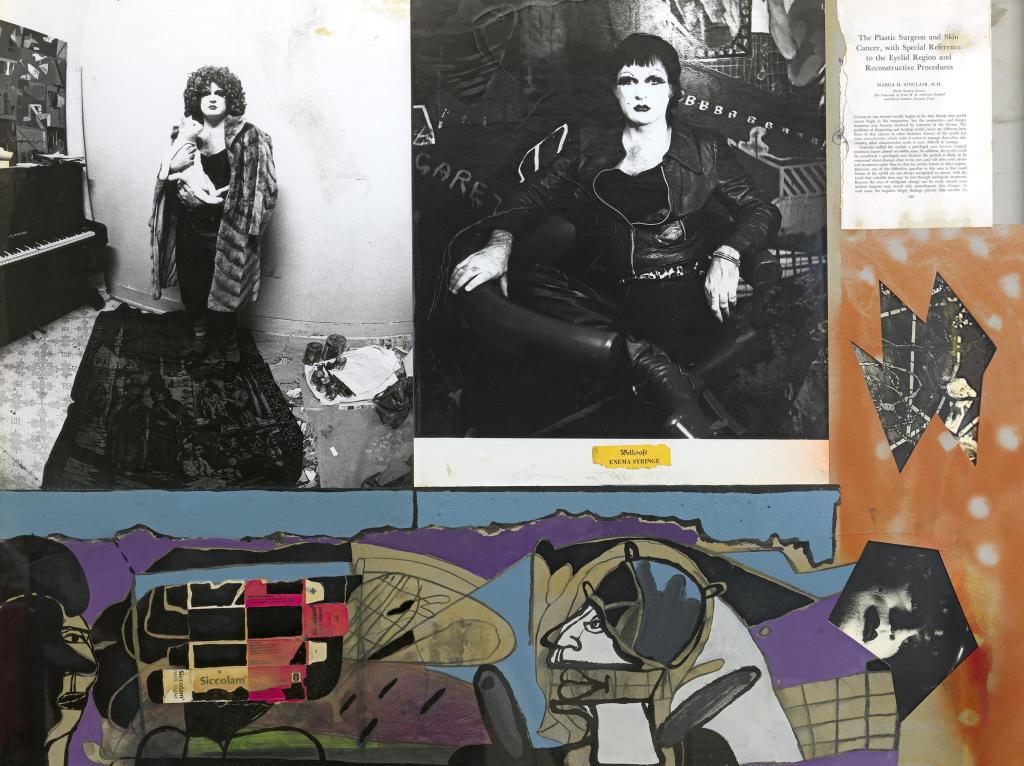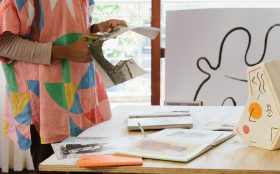Image: Gareth Sansom, Siccolam, 1976, collage of offset-photo lithographs, gelatin silver photographs, fibre tipped pen, enamel paint, polyvinyl acetate and charcoal on cardboard 81.0 x 101.0 cm. Courtesy the artist © Gareth Sansom/Administered by Viscopy, 2017.
Everything about this exhibition is big. As one walks along the massive corridor that leads to the first room the viewer is bombarded with the artist’s name and exhibition title in gigantic font. Large spaces nicely segue one to the other, comfortably accommodating the paintings that range from large to huge. The most intermit room, which houses the objects and photographs more overtly sexual in nature, is designed to confront. But more about that later. The spaces do justice to Sansom’s impressive oeuvre in this survey show featuring over 130 works which include suits of works on paper, photographs and some objects.

Image: Gareth Sansom, Yes?, 1976, gelatin silver photographs, enamel, pencil, fibre-tipped pen and crayon on cardboard 82.0 x 102.0 cm. Art Gallery of South Australia, Adelaide South Australian Government Grant, 1984 (848P26) © Gareth Sansom/Administered by Viscopy, 2017.
Although strongly influenced by British Pop artists of the 1960s and post-modernist R.B. Kitaj among others, the most enduring influence on Sansom’s work has been the artist Francis Bacon. Author and critic Sebastian Smee suggests the ‘contrived powerful contrasts between his blurred and bleeding figures and their bright, clean, geometric backgrounds, which [Bacon] laid down in sumptuous colours deliberately appearing commercial and arbitrary’ can be seen in Sansom’s approach to art making. An artist who has prided himself at remaining on the fringe of the mainstream art world for over 50 years, Sansom is regarded as avant-garde and a provocateur. His visually demanding works excavate, from the depths of his subconscious, shards and fragments of personal iconography that explore themes of identity, popular culture, religion and mortality, art history, sex and gender.
Rather than taking a traditional chronological approach to this untraditional artist, Simon Maidmont, the curator, deftly connects works from varying time periods by linking themes to give the viewer an idea of the artist’s intentions and development. Bates Motel, (2011) for example, an oil and enamel painting with an inkjet print on canvas, reflects the artist’s continued fascination with gender norms; it presents as a cacophony of colour and psychological symbolism that forms the interior of a monstrous abstracted figure. Images of Sansom dressed in drag, like the character Bates from Alfred Hitchcock’s 1960 psychological thriller Psycho, appear in either corner. An earlier work Rosebud (1965) a painting and collage on board is also inspired by the cinema and a homage to Orson Welles’s film Citizen Kane (1941). As with Bates Motel, this work has many references embedded in its imagery; fighter jets, a women’s head from a fashion magazine and a foot in a high heal shoe grab the viewer’s attention through a medley of colour and movement but perhaps without the psychological depth.

Image: Gareth Sansom, Bates Motel, 2011, oil and enamel paint and inkjet printon canvas198.0 x 228.6 cm. Private collection© Gareth Sansom/Administered by Viscopy, 2017.
Sansom’s continued fascination with pushing the boundaries of gender norms have their roots in some of his earliest work. His 1964 oil and enamel painting The blue masked transvestite, has at its centre a leering, androgynous figure dressed only in underwear and suspenders. Although confronting for its time, Sansom’s interesting painterly style and modernist and pop art influences may now be what grabs the viewer’s attention. Comparatively the photographs Forensic suite, (1979) and Forensic suite (1990) which are situated in a more intimate viewing space along with latex body parts aim to shock. But they are also an example of how times have changed. In an era of constant media attention on gender differences and equality and the more recent focus on the LGBTIQ community, this kind of imagery seems almost gratuitous.

Image: Gareth Sansom, The blue masked transvestite, 1964, oil and enamel paint on composition board167.5 x 136.6 cm. State Art Collection, Art Gallery of Western Australia, Perth Purchased 1989 (1989/0171) © Gareth Sansom/Administered by Viscopy, 2017.
Traditionally surveys are big exhibitions. Although it is important to celebrate the achievements of an important contemporary Australian artist such as Sansom, represented in collections both nationally and internationally, the question is the best way to do it. As a public institution what role should the NGV play in making art such as Sansom’s more accessible? Although the works in this exhibition are supported by didactic panels, labels and a handsome catalogue, it is an overwhelming show not just in shear size but complexity of imagery. Would a more educative approach to the artist’s work with limited examples of his art and interpretive multimedia support (visual and aural) be of more value to the art-going public? I’ll leave that for you to ponder along with these words by Reg Butler, teacher in Art History in the Faculty of Art, Design and Architecture at Monash University:
‘Gareth Sansom: Transformer, ultimately left one wanting less … the work was able to withstand all attempts by the curator and catalogue writers to impose any meaning on it for all the thematic rooms and ingenious matches. As it stands, virtually no one – maybe not even the artist himself – has a clue what is going on in the work, but that is to be expected at this early moment of the reception of a properly powerful body of practice.’
Rating: 3 ½ stars out of 5
Gareth Sansom: Transformer
NGV
15 Sep 17 – 28 Jan 18
Tours Tues & Sat, 1.30pm





